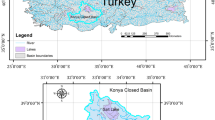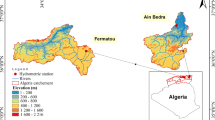Abstract
In water resources engineering, streamflow estimation models are of great importance. The use of black box models in determining streamflow estimation is preferred because it saves time compared to deterministic models. In addition, the data needed is less in quality and quantity and has a lower transaction volume. Therefore, accurate flow estimation plays a crucial role in water resources planning, management, and sizing of water structures. This study aimed to forecast the monthly streamflow using particle swarm optimization, least-squares support-vector machine, and signal processing models. For this purpose, 575 monthly data between 1963-2010 were used in Sivas, and 622 monthly data between 1960-2011 were used in Kayseri. The model structure used past streamflow, temperature, and precipitation values as input. During the installation of hybrid models, the inputs are divided into subcomponents with three levels of discrete Meyer mother wavelet and presented to the LS-SVM model. The performance of the models was evaluated with the help of statistical indicators such as determination coefficient, mean absolute error, Nash–Sutcliffe Efficiency, mean square error, Violin plots and visual Taylor diagrams. At the end of the study, EMD-LSSVM was the best streamflow estimation model at station 1501, and W-LSSVM was the most successful streamflow estimation model at station 1535.














Similar content being viewed by others
Data availability
Available from the corresponding author upon reasonable request.
References
Achite M, Mohammadi B, Jehanzaib M, Elshaboury N, Pham QB, Duan Z (2022) Enhancing Rainfall-Runoff Simulation via Meteorological Variables and a Deep-Conceptual Learning-Based Framework. Atmosphere 13(10):1688. https://doi.org/10.3390/atmos13101688
Alizadeh F, Faregh Gharamaleki A, Jalilzadeh R (2021) A two-stage multiple-point conceptual model to predict river stage-discharge process using machine learning approaches. J Wat Clim Change 12(1):278–295. https://doi.org/10.2166/wcc.2020.006
Başakın EE, Ekmekcioğlu Ö, Özger M (2021) Drought prediction using hybrid soft-computing methods for semi-arid region. Model Earth Syst Environ 7(4):2363–2371. https://doi.org/10.1007/s40808-020-01010-6
Başakın EE, Ekmekcioğlu Ö, Çıtakoğlu H, Özger M (2022) A new insight to the wind speed forecasting: robust multi-stage ensemble soft computing approach based on pre-processing uncertainty assessment. Neural Comput Applic 34(1):783–812. https://doi.org/10.1007/s00521-021-06424-6
Bokde N, Feijóo A, Villanueva D, Kulat K (2019) A review on hybrid empirical mode decomposition models for wind speed and wind power prediction. Energies 12(2):254. https://doi.org/10.3390/en12020254
Chai T, Draxler RR (2014) Root mean square error (RMSE) or mean absolute error (MAE). Geosci Model Dev Discuss 7(1):1525–1534. https://doi.org/10.5194/gmd-7-1247-2014,2014
Chen X, Huang J, Han Z, Gao H, Liu M, Li Z, Liu X, Li Q, Qi H, Huang Y (2020) The importance of short lag-time in the runoff forecasting model based on long short-term memory. J Hydrol 589:125359. https://doi.org/10.1016/j.jhydrol.2020.125359
Dawson CW, Wilby RL (2001) Hydrological modelling using artificial neural networks. Progress Phys Geogr 25(1):80–108. https://doi.org/10.1177/030913330102500104
Dazzi S, Vacondio R, Mignosa P (2021) Flood stage forecasting using machine-learning methods: a case study on the Parma River (Italy). Water 13(12):1612. https://doi.org/10.3390/w13121612
Eberhart R, Kennedy J (1995) A new optimizer using particle swarm theory. MHS’95 Proceedings of the 16th international symposium on micro machine and human science. IEEE, Nagoya, pp 39–43. https://doi.org/10.1109/MHS.1995.494215
Efe R (1996) Kızılırmağın Akım ve Rejim Özellikleri. Öneri Dergisi 1(4):39–60. https://doi.org/10.14783/maruoneri.710445
Gao S, Huang Y, Zhang S, Han J, Wang G, Zhang M, Lin Q (2020) Short-term runoff prediction with GRU and LSTM networks without requiring time step optimization during sample generation. J Hydrol 589:125188. https://doi.org/10.1016/j.jhydrol.2020.125188
Granata F, Gargano R, De Marinis G (2016) Support vector regression for rainfall-runoff modeling in urban drainage: A comparison with the EPA's storm water management model. Water 8(3):69. https://doi.org/10.3390/w8030069
Hintze JL, Nelson RD (1998) Violin plots: a box plot-density trace synergism. Am Stat 52(2):181–184
Huang NE, Shen Z, Long SR, Wu MC, Shih HH, Zheng Q, Liu HH (1998) The empirical mode decomposition and the Hilbert spectrum for non-linear and non-stationary time series analysis. Proc R Soc London Series A: Mathematical, physical and engineering sciences 454(1971):903–995. https://doi.org/10.1098/rspa.1998.0193
Huang S, Chang J, Huang Q, Chen Y (2014) Monthly streamflow prediction using modified EMD-based support vector machine. J Hydrol 511:764–775. https://doi.org/10.1016/j.jhydrol.2014.01.062
Kadkhodazadeh M, Farzin S (2021) A novel LSSVM model integrated with GBO algorithm to assessment of water quality parameters. Water Resources Manag 35(12):3939–3968. https://doi.org/10.1007/s11269-021-02913-4
Kasiviswanathan K, He J, Sudheer KP, Tay JH (2016) Potential application of wavelet neural network ensemble to forecast streamflow for flood management. J Hydrol 536:161–173. https://doi.org/10.1016/j.jhydrol.2016.02.044
Kaytez F, Taplamacioglu MC, Cam E, Hardalac F (2015) Forecasting electricity consumption: A comparison of regression analysis, neural networks and least squares support vector machines. Int J Electr Power Energy Syst 67:431–438. https://doi.org/10.1016/j.ijepes.2014.12.036
Khosravi K, Barzegar R, Miraki S, Adamowski J, Daggupati P, Alizadeh MR, Alami MT (2020) Stochastic modeling of groundwater fluoride contamination Introducing lazy learners. Groundwater 58(5):723–734. https://doi.org/10.1111/gwat.12963
Kumar S, Tiwari MK, Chatterjee C, Mishra A (2015) Reservoir inflow forecasting using ensemble models based on neural networks, wavelet analysis and bootstrap method. Water Resources Manag 29:4863–4883. https://doi.org/10.1007/s11269-015-1095-7
Litjens GBMA, Worrell E, Van Sark WGJHM (2018) Assessment of forecasting methods on performance of photovoltaic-battery systems. Appl Energy 221:358–373. https://doi.org/10.1016/j.apenergy.2018.03.154
Mohammadi B, Safari MJS, Vazifehkhah S (2022). IHACRES, GR4J and MISD-based multi conceptual-machine learning approach for rainfall-runoff modeling. Sci Rep 12(1):. https://doi.org/10.1038/s41598-022-16215-1
Mosavi A, Ozturk P, Chau KW (2018) Flood prediction using machine learning models: Literature review. Water 10(11):1536. https://doi.org/10.3390/w10111536
Noury M, Sedghi H, Babazedeh H, Fahmi H (2014) Urmia lake water level fluctuation hydro informatics modeling using support vector machine and conjunction of Wavelet and neural network. Water Resources 41(3):261–269. https://doi.org/10.1134/S0097807814030129
Novoa-Hernández P, Corona CC, Pelta DA (2011) Efficient multi-swarm PSO algorithms for dynamic environments. Memetic Comput 3(3):163–174. https://doi.org/10.1007/s12293-011-0066-7
Okkan U, Serbes ZA (2012) Rainfall–runoff modeling using least squares support vector machines. Environmetrics 23(6):549–564. https://doi.org/10.1002/env.2154
Okkan U, Serbeş ZA, Gedik N (2018) ANN application based on Levenberg-Marquardt algorithm with Matlab: Monthly rainfall-runoff modeling. Dicle Univ Eng Fac J Eng 9(1):351–362
Seo Y, Kim S, Kisi O, Singh VP, Parasuraman K (2016) River stage forecasting using wavelet packet decomposition and machine learning models. Water Resources Manag 30(11):4011–4035. https://doi.org/10.1007/s11269-016-1409-4
Seo Y, Kim S, Singh VP (2018) Machine learning models coupled with variational mode decomposition: A new approach for modeling daily rainfall-runoff. Atmosphere 9(7):251. https://doi.org/10.3390/atmos9070251
ShabriSuhartono A (2012) Streamflow forecasting using least-squares support vector machines. Hydrol Sci J 57(7):1275–1293. https://doi.org/10.1080/02626667.2012.714468
Sudheer C, Maheswaran R, Panigrahi BK, Mathur S (2014) A hybrid SVM-PSO model for forecasting monthly streamflow. Neural Comput Applic 24(6):1381–1389. https://doi.org/10.1007/s00521-013-1341-y
Talei A, Chua LH (2012) Influence of lag time on event-based rainfall–runoff modeling using the data driven approach. J Hydrol 438:223–233. https://doi.org/10.1016/j.jhydrol.2012.03.027
Taylor KE (2001) Summarizing multiple aspects of model performance in a single diagram. J Geophys Res: Atmospheres 106(D7):7183–7192. https://doi.org/10.1029/2000JD900719
Tiwari MK, Chatterjee C (2010) Development of an accurate and reliable hourly flood forecasting model using wavelet–bootstrap–ANN (WBANN) hybrid approach. J Hydrol 394(3–4):458–470. https://doi.org/10.1016/j.jhydrol.2010.10.001
Wang WC, Xu DM, Chau KW, Chen S (2013) Improved annual rainfall-runoff forecasting using PSO–SVM model based on EEMD. J Hydroinform 15(4):1377–1390. https://doi.org/10.2166/hydro.2013.134
Wang X, Wang Y, Yuan P, Wang L, Cheng D (2021) An adaptive daily runoff forecast model using VMD-LSTM-PSO hybrid approach. Hydrol Sci J 66(9):1488–1502. https://doi.org/10.1080/02626667.2021.1937631
Wang L, Lv Z, Li Q (2015) Road friendliness optimization of heavy vehicle suspension based on particle swarm algorithm. In 4th International Conference on Computer, Mechatronics, Control and Electronic Engineering (ICCMCEE 2015). Atlantis Press, pp. 1321–1326. Hangzhou, China. https://doi.org/10.2991/iccmcee-15.2015.249
Yapo PO, Gupta HV, Sorooshian S (1996) Automatic calibration of conceptual rainfall-runoff models: sensitivity to calibration data. J Hydrol 181(1–4):23–48. https://doi.org/10.1016/0022-1694(95)02918-4
Yaseen ZM, Ebtehaj I, Bonakdari H, Deo RC, Mehr AD, Mohtar WHMW, ..., Singh VP (2017). Novel approach for streamflow forecasting using a hybrid ANFIS-FFA model. J Hydrol 554:263-276. https://doi.org/10.1016/j.jhydrol.2017.09.007
Zare M, Koch M (2014). An analysis of MLR and NLP for use in river flood routing and comparison with the Muskingum method. In 11th International Conference on Hydroscience & Engineering (ICHE). Hamburg, Germany.
Zhang H, Liu L, Jiao W, Li K, Wang L, Liu Q (2022) Watershed runoff modeling through a multi-time scale approach by multivariate empirical mode decomposition (MEMD). Environ Sci Pollut Res 29(2):2819–2829. https://doi.org/10.1007/s11356-021-13676-1
Zhao X, Chen X, Xu Y, Xi D, Zhang Y, Zheng X (2017) An EMD-based chaotic least squares support vector machine hybrid model for annual runoff forecasting. Water 9(3):153. https://doi.org/10.3390/w9030153
Zounemat-Kermani M, Matta E, Cominola A, Xia X, Zhang Q, Liang Q, Hinkelmann R (2020) Neurocomputing in surface water hydrology and hydraulics: A review of two decades retrospective, current status and future prospects. J Hydrol 588:125085. https://doi.org/10.1016/j.jhydrol.2020.125085
Acknowledgments
The author thanks the General Directorate of Electric Power Resources Survey and Development Administration and General Directorate of Meteorology for data provided, the Editor, and the anonymous reviewers for their contributions to the content and development of this paper.
Funding
No funding was received for conducting this study.
Author information
Authors and Affiliations
Contributions
O. M. Katipoğlu contributed to the data collection, data analysis, writing findings, and conclusions. M. Sarıgöl contributed with literature review and writing methods. All authors read and approved the final manuscript.
Corresponding author
Ethics declarations
Competing interests
The authors declare no competing interests.
Ethical approval
The manuscript complies with all the ethical requirements. The paper was not published in any journal.
Conflicts of interest/Competing interests
The author declares no conflict of interest.
Consent to participate
Not applicable.
Consent for publication
Not applicable.
Additional information
Communicated by: H. Babaie
Publisher's Note
Springer Nature remains neutral with regard to jurisdictional claims in published maps and institutional affiliations.
Rights and permissions
Springer Nature or its licensor (e.g. a society or other partner) holds exclusive rights to this article under a publishing agreement with the author(s) or other rightsholder(s); author self-archiving of the accepted manuscript version of this article is solely governed by the terms of such publishing agreement and applicable law.
About this article
Cite this article
Katipoğlu, O.M., Sarıgöl, M. Improving the accuracy of rainfall-runoff relationship estimation using signal processing techniques, bio-inspired swarm intelligence and artificial intelligence algorithms. Earth Sci Inform 16, 3125–3141 (2023). https://doi.org/10.1007/s12145-023-01081-w
Received:
Accepted:
Published:
Issue Date:
DOI: https://doi.org/10.1007/s12145-023-01081-w




